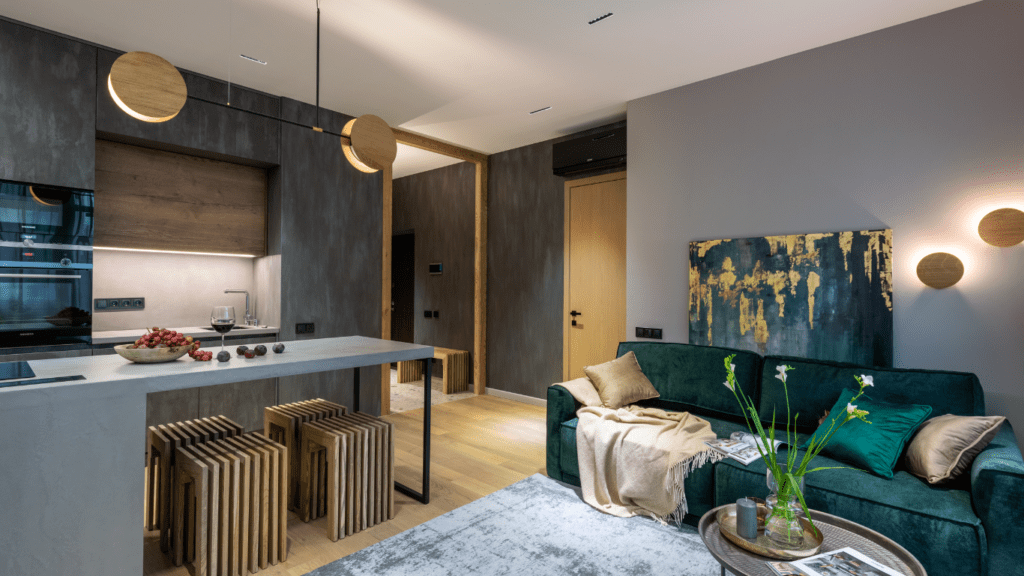What Is Japandi, Really?
Japandi is more than a design trend it’s a lifestyle philosophy grounded in harmony, simplicity, and purposeful living. At its core, Japandi blends the elegance of Japanese aesthetics with the cozy functionality of Scandinavian interiors, creating a hybrid style that feels both grounded and breathable.
The Fusion: East Meets North
Japandi reflects the best of two well established design legacies:
Japanese Zen: Minimalism with soul, focused on balance, imperfection (wabi sabi), and natural tranquility
Scandinavian Functionality: Clean lines, cozy textures (hygge), and a commitment to livability and comfort
Together, they form a design approach that prioritizes mindfulness over materialism.
Core Principles of Japandi
What makes Japandi so distinct is its foundation of intentional choices. This style isn’t about following trends, but about curating a space that soothes and serves.
Simplicity: Eliminate excess every item has a purpose
Calm: Soothing color palettes and uncluttered layouts
Craftsmanship: Preference for well made, timeless pieces
Restraint: Minimal doesn’t mean bare it means mindful
Why Japandi Resonates Now
In a world overflowing with noise, clutter, and digital overload, Japandi offers a visual and emotional exhale.
It invites rest and recovery through intentional surroundings
It promotes slowing down and focusing on what matters
It aligns with sustainability and conscious consumer choices
Japandi isn’t just a style it’s a response to the chaos of modern life.
Key Elements that Define Japandi
Japandi design doesn’t try to impress with flash. It’s quiet, grounded, and deliberate. Materials come first: wood, stone, bamboo always natural, with visible grain and texture. You won’t find chrome or plastic here. Surfaces breathe. Everything feels like it belongs to the earth.
The color palette follows suit. Think warm beige, foggy gray, moss green not loud, not sterile. These tones aren’t just a style move; they set the rhythm of a room. They’re calming. They give the eye a place to rest.
Furniture lives low to the ground, built with purpose. It serves, it supports, it doesn’t show off. No extra flourishes. Pieces are selected, not stuffed in. You should feel space around each object.
And that’s really the baseline: space. Japandi rooms flow. There’s breathing room not just physically, but emotionally. Lines are clean, pathways open, storage hidden. Each choice is meant to create a sense of quiet. This isn’t just how a room looks it’s how it feels.
How Japandi Goes Deeper Than Aesthetic

Japandi isn’t just about what a space looks like. It’s about how it feels and what it quietly teaches you to prioritize. At its core, Japandi design supports emotional and mental clarity. Spaces are stripped of the unnecessary, so your mind has room to breathe. Every object has a function. Every line has intention. That kind of calm doesn’t scream; it settles in.
Part of the magic is how it blends warmth and stillness. The Scandinavian concept of hygge adds comfort soft fabrics, warm lighting, lived in furniture. Wabi sabi from Japan brings a sense of acceptance and quiet. These ideas work together. One soothes, the other stills. No chaos. No clutter. Just space that supports how you want to live, not how you want to impress.
Japandi isn’t interior design as performance. It’s design as a daily practice. A way to live lighter, slower, and more on purpose. You don’t just walk into a Japandi room you decompress in it.
How Japandi Differs from Traditional Minimalism
While often grouped with minimalism, Japandi brings distinct qualities that set it apart both stylistically and philosophically.
Depth Over Sterility
Traditional minimalism can sometimes veer into stark or sterile territory. Japandi, however, softens simplicity through warmth. Its use of natural materials, soft lighting, and layered textures creates a space that feels lived in, not lifeless.
Incorporates cozy textures and warm neutrals
Uses natural imperfections to bring personality
Prioritizes comfort without sacrificing clarity
Celebrating Imperfection
Rather than concealing wear or treating age as a flaw, Japandi embraces the aesthetic of imperfection inspired by the Japanese concept of wabi sabi.
Weathered wood, patina finishes, and handmade ceramics are welcome
Materials are chosen for the way they age gracefully
Imperfection tells a story, adding soul to a space
Intentional Design, Rooted in Culture
Japandi is not just a look it’s a mindset shaped by heritage. Where Scandinavian design leans into function and comfort, Japanese design contributes discipline and mindfulness. The fusion results in a design style that’s deeply intentional.
Every object has both a purpose and a place
Design choices are guided by utility and emotion
Cultural wisdom shapes aesthetic restraint
Explore the broader philosophy in modern minimalism
Getting the Japandi Look at Home
Japandi starts with subtraction. Clearing space isn’t just about tidiness it’s a mindset shift. You’re not decorating, you’re curating. If it doesn’t serve a purpose or bring calm, it doesn’t stay. This doesn’t mean sterile. It means intentional.
Once there’s breathing room, focus on fewer, better things. One beautiful chair can speak louder than a cluttered seating area. Go for real materials think oak, linen, or clay that age well and feel grounded. Quality anchors the space; quantity just crowds it.
Color plays it cool but textured. Stick with soft Scandinavian neutrals sand, stone, smoke and then add quiet dimension through Japanese textures like raw wood or handmade ceramics. The contrast lies in the feel, not the hue.
As for lighting, ditch the harsh overheads. Aim for glow, not glare. Use hidden sources, paper lanterns, or dimmable floor lamps to create pockets of warmth, not spotlights. Japandi lighting whispers instead of shouts.
The goal isn’t just a good looking room it’s one that calms you every time you step into it.
Why Japandi Isn’t Going Anywhere
Japandi a quiet fusion of form and function feels like an antidote to trend fatigue. In a world where designs get copied, mass produced, and replaced every season, Japandi design holds its ground. It doesn’t scream for attention. It invites stillness. And in 2024, with endless scrolling and short lived dopamine hits, that matters.
Its timeless appeal starts with intention. Every piece, every material, every color earns its place. Fast fashion doesn’t stand a chance because Japandi was never about more it’s always been about better. Solid woods over particle boards. Linen over synthetics. Natural light over bold statements. The result is a kind of design that doesn’t date it settles in.
At its core, Japandi is about sustainability. Not just eco friendly materials (though those matter), but a way of thinking: buy once, use long, care well. It leans into aging and imperfection, letting wear add story instead of subtract value. That alone makes it quietly radical in a throwaway culture.
On a deeper level, Japandi design offers peace. Calm colors, uncluttered rooms, and a respect for space help create environments where people can breathe. It’s not about putting life on pause it’s about creating a steady rhythm in the background. Something solid to come home to.
For more on living with less but better, explore the ideas behind modern minimalism.


 Betsylie Sheetsin – Home Renovation Expert
Betsylie Sheetsin serves as the Home Renovation Expert at Castle Shelf House, specializing in giving practical advice for both small and large-scale home improvements. With years of experience in construction and renovation, Betsylie understands the importance of blending durability with design. Her insights into home renovation projects, along with expert advice on the latest materials and techniques, empower homeowners to tackle even the most ambitious projects confidently.
Betsylie Sheetsin – Home Renovation Expert
Betsylie Sheetsin serves as the Home Renovation Expert at Castle Shelf House, specializing in giving practical advice for both small and large-scale home improvements. With years of experience in construction and renovation, Betsylie understands the importance of blending durability with design. Her insights into home renovation projects, along with expert advice on the latest materials and techniques, empower homeowners to tackle even the most ambitious projects confidently.
